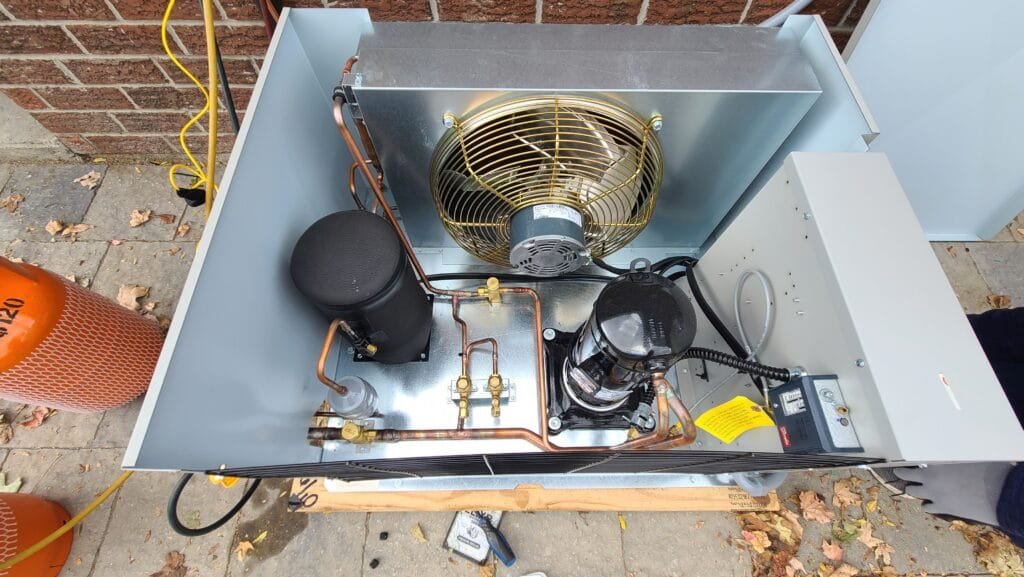Specialist Suggestions on Commercial Refrigeration Repair for Toronto Businesses
Specialist Suggestions on Commercial Refrigeration Repair for Toronto Businesses
Blog Article
Making Best Use Of Performance: Commercial Refrigeration Fixing Techniques for Cost-Effective Solutions

Assessing Refrigeration System Performance
To properly examine the performance of a business refrigeration system, it is important to perform detailed assessments of its crucial parts and operational specifications. The initial step in evaluating system performance is checking out the functionality of the compressor. The compressor plays a vital duty in maintaining the preferred temperature level within the refrigeration unit. Problems with the compressor can cause poor cooling, temperature fluctuations, and raised energy consumption. Carrying out routine assessments and performance tests on the compressor can help determine prospective problems beforehand and prevent costly break downs.
Keeping track of cooling agent levels and pressures is likewise important in assessing system performance. Reduced refrigerant degrees or uncommon pressures can show leaks or malfunctioning elements that require immediate interest to prevent system failures and pricey repairs. By methodically assessing these functional parameters and essential parts, businesses can ensure their industrial refrigeration systems run at peak efficiency levels, reducing downtime and maximizing power performance.

Carrying Out Preventative Maintenance Measures
Examining the performance of a commercial refrigeration system gives important understandings that can notify the implementation of preventative maintenance actions vital for sustaining ideal functionality and longevity. Preventative upkeep is a proactive strategy focused on identifying and addressing prospective concerns before they rise into expensive troubles that interrupt procedures. By establishing a normal upkeep routine, refrigeration systems can run efficiently, lowering energy intake and minimizing the threat of unexpected failures. Key preventative maintenance procedures consist of checking and cleansing condenser coils, inspecting cooling agent levels, making sure correct air movement, and calibrating temperature controls. Additionally, keeping an eye on temperature level and moisture levels, inspecting door seals, and attending to any type of uncommon sounds or smells quickly are necessary steps in preventative upkeep. Implementing these measures not only extends the life expectancy of the devices yet additionally boosts food safety by maintaining consistent storage space temperature levels. Inevitably, buying preventative upkeep actions is an affordable approach that helps services stay clear of pricey repair work and downtime, making certain dependable and continuous refrigeration system performance.
Identifying Common Refrigeration Issues
One of the crucial aspects in preserving industrial refrigeration systems is promptly identifying typical problems that might emerge during their procedure. Additionally, defective gaskets on doors, resulting in air leakages, can create the refrigeration system to function harder to preserve the preferred temperature. By promptly recognizing and attending to these typical refrigeration issues, businesses can make certain the reliable procedure of their systems and lessen costly repair work.
Using Energy-Efficient Repair Work Techniques
When thinking about business refrigeration fixing, executing energy-efficient methods is vital to enhancing the system's efficiency and reducing operational costs. One of the vital techniques in accomplishing power performance is guaranteeing that the refrigeration system is correctly maintained. Normal maintenance, Continue such as cleansing condenser coils, looking for cooling agent leaks, and adjusting temperature settings, can significantly improve energy performance.
One more energy-efficient fixing technique is updating to high-efficiency parts - commercial refrigeration repair. By replacing older, less reliable components with energy-efficient choices, such as ECM fan motors or LED illumination, services can minimize read more energy consumption and reduced utility expenses. Additionally, mounting programmable thermostats and power monitoring systems can assist regulate temperature levels better, avoiding unnecessary energy usage
Furthermore, optimizing the system's insulation and securing any type of leaks can likewise contribute to power savings. Proper insulation assists keep constant temperature levels within the refrigeration system, reducing the work on the system and boosting total effectiveness. By incorporating these energy-efficient repair methods, services can not only minimize their ecological influence however also attain long-lasting expense savings.
Optimizing Refrigeration System Life Expectancy
To make sure the long life and optimum efficiency of commercial refrigeration systems, preserving energy-efficient repair practices is vital, with an emphasis currently moving in the direction of maximizing the refrigeration system life expectancy. Optimizing the lifespan of a refrigeration system includes positive maintenance, timely fixings, and adherence to manufacturer standards.
Furthermore, investing in top quality parts and components throughout fixings and substitutes can improve the resilience of the refrigeration system. By prioritizing aggressive maintenance and making use of top quality elements, organizations can enhance the lifespan of their industrial refrigeration systems, eventually reducing downtime and operational costs.
Conclusion
Finally, by on a regular basis assessing check here refrigeration system performance, applying preventative upkeep actions, recognizing common refrigeration problems, making use of energy-efficient repair work methods, and maximizing the system's life-span, companies can take full advantage of performance and decrease costs connected with industrial refrigeration fixing. These cost-efficient solutions aid to ensure that refrigeration systems run at peak efficiency, eventually leading to raised efficiency and profitability for services in the long run.

When thinking about industrial refrigeration fixing, executing energy-efficient strategies is extremely important to maximizing the system's efficiency and reducing operational prices.To ensure the longevity and ideal performance of industrial refrigeration systems, maintaining energy-efficient fixing practices is important, with a focus now shifting towards making the most of the refrigeration system life expectancy. Enhancing the life-span of a refrigeration system entails aggressive upkeep, prompt repairs, and adherence to manufacturer guidelines.
Report this page